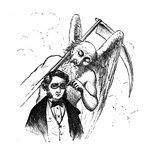
The Culture of Death & the Death of a Culture
AN AMERICAN EXPORT TO JAPAN
On November 25, 1970, the famous and eccentric Japanese poet and playwright Yukio Mishima directed and starred in what was arguably his most dramatic role — that of his own death. After seizing control of a defense-force compound and taking a high-ranking military official hostage, Mishima committed seppeku, ritual suicide in the manner of the ancient samurai. The causes that brought Mishima to this bold and violent end were as complex as the man himself, but it was, at least in part, a protest against what he perceived to be the corruption of Japanese culture by Western influences. In short, he felt that Japan had lost her soul.
Mishima’s concern still obtains: Has Japan been adversely affected by so-called Western influences? No single article could possibly cover the enormous breadth and depth of Japan’s history and culture, nor even the complexities of her interaction with Western societies, so let us focus on one particular phenomenon — that of Japan’s rapidly declining birthrate. The problem of low birthrate is, of course, not an exclusively Japanese one. The United States and much of western Europe have also seen marked declines in birthrate over the past several decades. But it is in Japan where the problem and its ramifications, both present and projected, are most evident.
For four years, from 1996 to 2000, I was employed as a teacher of English in Kumamoto Prefecture in southern Japan. During that time I met and married a Japanese woman, and our first son was born there. I vividly recall going with my wife to the clinic to verify that she was indeed with child. After confirming that she was, the first thing the doctor asked us, in a rather matter-of-fact manner, was whether we wanted to keep the baby. I remember with equal clarity my offense to the question as, in my mind, there really was no question about it. A baby had been conceived and, in accordance with natural law, that child would be nurtured and brought into the world. To this day, I don’t know whether the doctor’s question was a matter of protocol within the Japanese healthcare system, but it left a lasting impression on me.
The first time I saw my newborn son was from behind the large window of the post-delivery room in which there were some twenty-five little beds. But only two of those beds were occupied: one by my son and one by a baby girl who had been born the same day. Though filled with the joy of becoming a new father, I couldn’t help but be struck by the image of this room with so many empty little beds. I didn’t give the matter too much thought at the time, reasoning that perhaps it was just a “slow” time of the year.
You May Also Enjoy
Much popular Catholic literature on NFP is utilitarian, claiming that obeying Church teaching results in a happier, more exciting bedroom experience.
The right kind of NFP course offers a splendid opportunity both for a new Christ-centered evangelization and for teaching the "what" and the "why" of NFP.
The encyclical is a profound reflection on marital love that was later deepened and contextualized in more pastoral and juridical (canon law) forums.

